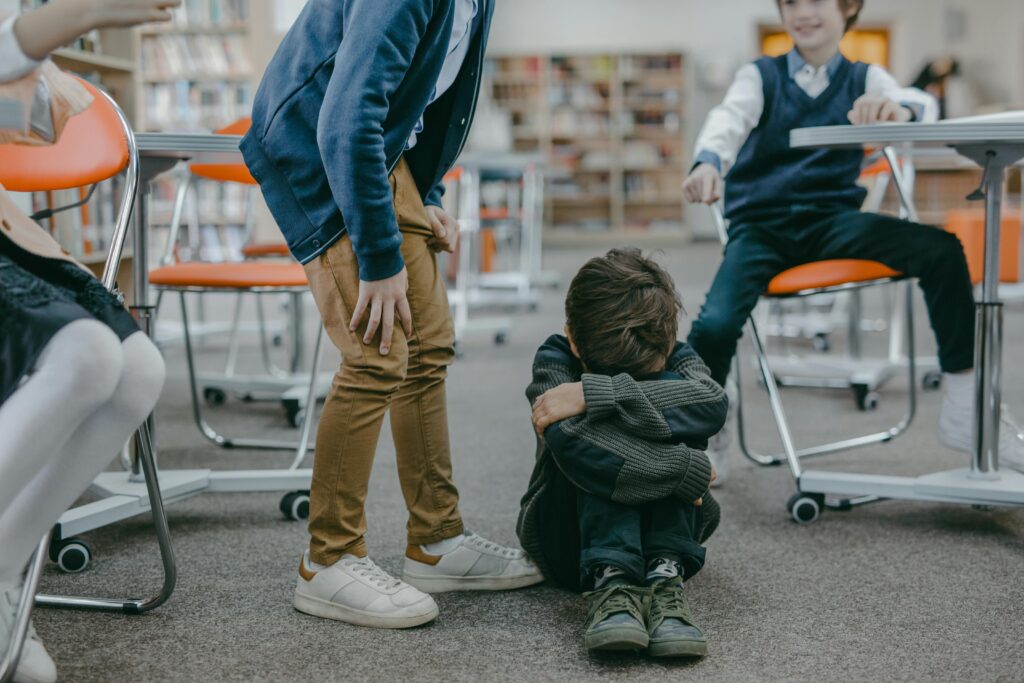Being a child can be tough. But as a parent looking at how our children are doing in school or with their friends, navigating someone else’s childhood can be just as challenging. Take the friendships our children make. Sometimes it can be difficult to distinguish harmful bullying from good-natured teasing. How do we know which is which, and when we may need to step in and help our child through a certain situation?
To get started answering this complicated question, it’s first important to look at the nature of both teasing and bullying, and the forms that each activity can take.
For many growing kids, teasing can be good-natured and fun. It’s a way to build and expand friendships, develop communication skills, and also assert their identity within a group. But sometimes, teasing also still hurts.
Bullying, on the other hand, is a form of aggression. It’s intended to hurt someone, and typically involves repeated behaviors meant to assert power, control, and dominance over peers.
Teasing isn’t always meant to be mean; It’s one of many forms of social communication, and among friends, children can learn to laugh and move on.
Bullying, on the other hand, is always serious. Kids who are bullied regularly tend to experience a wealth of negative issues, ranging from poorer physical health to problems adjusting in school to identify issues, lower self-esteem, and other forms of emotional pain. Children who are victims of bullying also often experience more loneliness, anxiety, depression, and a host of other ills that no child should ever have to deal with.
Bullying doesn’t just affect the victim—it also impacts those who witness it, from “bystanders” who passively watch to “upstanders” who might speak up against the bullying. Many schools have existing anti-bullying programs where educators may try to show children how to respond when they witness bullying, since most bullying incidents occur when adults aren’t watching. But sometimes as parents, we may also need to do more.
If you know or suspect your child is being bullied, you may feel helpless to stop it on your own. But the good news is that no matter the situation, there are things that we can all do to address these kinds of issues. Here are 5 practical ways to help any child better deal with potential bullying.
1. Look For Signs
Parents can look for symptoms at home that may show a child is a victim of bullying. Your child may seem anxious or easily upset. They may have physical symptoms, such as stomach aches, or may complain about having nightmares. Perhaps, they may even want to avoid taking the bus or going to school altogether. If concerned, it may help to ask your child questions about the kids they’re around. Checking in with the teacher to gain additional insights is another very useful option. You’ll be surprised how much a teacher can pick up about their students’ behaviors and circumstances.
2. Approach the Situation Calmly
When many parents find out that their child is being bullied, their first reaction might be anger or frustration. Sometimes parents may even want to contact the parents of the bully. But stepping into the situation in this way is usually not the best approach, according to child development experts. Instead, first ask your child to describe what happened, including who was involved, where and when it occurred, and if there were any witnesses. Then, try to determine if the bullying is an isolated incident or a recurring problem. Understanding the frequency and nature of the bullying can help in addressing it effectively. Finally, always be sure to connect with someone at the school after you’ve tried a few tactics, and if the bullying persists or becomes more severe.
3. Support Your Child by Listening
Children may be reluctant to talk about bullying because they might feel embarrassed or worry the parent will react too strongly or too quickly. It’s natural to want to protect your child and stop the bullying immediately, but this is often not realistic. Instead, listen calmly and praise your child for talking openly about what’s happening. Some children feel it’s their fault or that they deserve being teased. Some worry their parents will urge them to fight back and are scared to confront the “enemy.” It’s helpful for parents to explain that it’s the bully who is behaving poorly—not them for backing off. What children most need from you is to listen and support them.
4. Practice Different Responses to Use on the Bully
A. Positive Body Language
Another way to help your child is to practice different responses to the bully. This may involve developing more positive body language, for example. Children can practice making different faces—sad, happy, mad, brave—and then commit to always using their “brave” face around bullies. They can also practice looking the bully in the eyes instead of looking down or away. Discuss with them how walking with confidence can make a difference in how any potential bully sees them. A confident person can be more intimidating to a bully. Another important key to encourage when it comes to positive body language is to tell your child to avoid crying, whining, and getting upset whenever possible in the presence of their bully. Tell the child that if they need to express their emotions in these ways, that’s OK—they just need to do it in a safe space where the bully isn’t present.
B. Responsive Deflection
In addition to more positive body language, some school psychologists also suggest a more creative approach to bullying when children are taunted with words. Instead of fighting back, for example, a child can remove the power of bullying by responding casually with a friendly tone. For instance, a bully might say something like, “I’m having a party and you’re not invited.” Instead of responding with a comment like, “That’s so mean,” or “I don’t want to come to your stupid party anyway,” the child can respond, “I have other plans anyway. Hope you have a great party.” After all, it’s best to help our children to stay kind even in the face of bullying. Responses that don’t reveal discomfort or hurt deprive the bullies of what they are seeking: their ability to inflict emotional pain on another.
C. Practice, not Perfection
As you develop these strategies, also always remind your child that their behaviors and reactions don’t have to be perfect. It’s not always easy to respond in the way we intended to or want to. Help your child understand that social situations take practice just like anything else. Then, take the time to practice some responses with them. It can actually lighten the situation as, together, you invent creative responses to any potential bullying that might arise.
5. Build Your Child’s Confidence
A couple of long-term approaches that can help to become more resistant to bullying are to encourage your child to be involved in hobbies, extracurricular activities, and social situations that bring out their strengths. The better they feel about themselves, the less likely it becomes that bullying will affect their self-esteem. They also may make some good friends through these activities. And, as countless movies have shown us, there’s tremendous power in numbers when it comes to bullying. The presence of even one buddy reduces the likelihood of your child being bullied significantly.
Sadly, bullying is something many of us will go through in our journey to adulthood. There’s simply no way to avoid it entirely. But when it does occur, it’s important to remember that there are a variety of ways to help children cope with whatever form of bullying they might be experiencing. It’s undeniably a complex problem, but addressing the situation in a mature and practical way is always best.
As a parent, prioritize open communication and avoid overreacting. Most importantly, always try to keep an eye on how the bullying is progressing. It’s essential to recognize when any situation becomes so serious that you need to contact appropriate authorities. Hopefully, things never progress that far! Give your child a hug, listen to their issues and be as supportive as possible, knowing that these rough patches will pass and things will get better for everyone.
For additional information on parenting and child-based health and wellness, visit the Innergy App!


